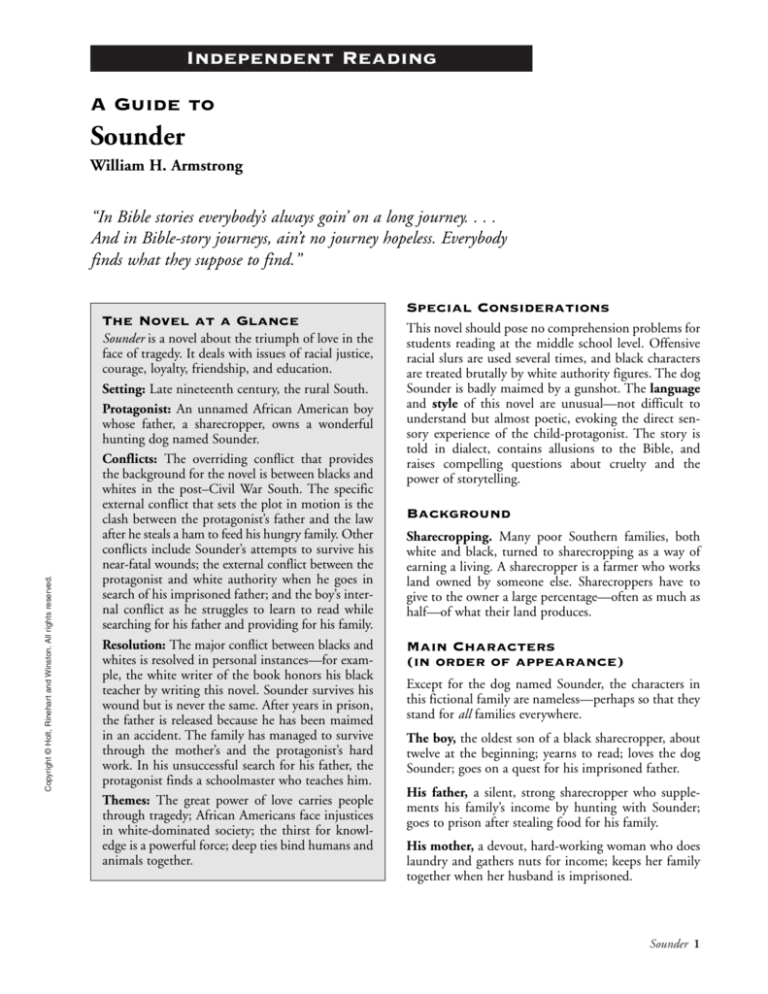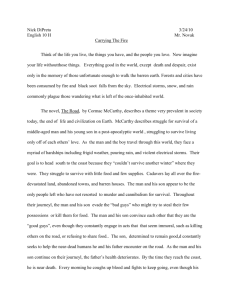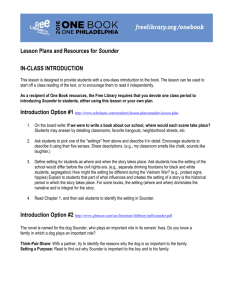
Independent Reading
A Guide to
Sounder
William H. Armstrong
“In Bible stories everybody’s always goin’ on a long journey. . . .
And in Bible-story journeys, ain’t no journey hopeless. Everybody
finds what they suppose to find.”
Special Considerations
Copyright © Holt, Rinehart and Winston. All rights reserved.
The Novel at a Glance
Sounder is a novel about the triumph of love in the
face of tragedy. It deals with issues of racial justice,
courage, loyalty, friendship, and education.
Setting: Late nineteenth century, the rural South.
Protagonist: An unnamed African American boy
whose father, a sharecropper, owns a wonderful
hunting dog named Sounder.
Conflicts: The overriding conflict that provides
the background for the novel is between blacks and
whites in the post–Civil War South. The specific
external conflict that sets the plot in motion is the
clash between the protagonist’s father and the law
after he steals a ham to feed his hungry family. Other
conflicts include Sounder’s attempts to survive his
near-fatal wounds; the external conflict between the
protagonist and white authority when he goes in
search of his imprisoned father; and the boy’s internal conflict as he struggles to learn to read while
searching for his father and providing for his family.
Resolution: The major conflict between blacks and
whites is resolved in personal instances—for example, the white writer of the book honors his black
teacher by writing this novel. Sounder survives his
wound but is never the same. After years in prison,
the father is released because he has been maimed
in an accident. The family has managed to survive
through the mother’s and the protagonist’s hard
work. In his unsuccessful search for his father, the
protagonist finds a schoolmaster who teaches him.
Themes: The great power of love carries people
through tragedy; African Americans face injustices
in white-dominated society; the thirst for knowledge is a powerful force; deep ties bind humans and
animals together.
This novel should pose no comprehension problems for
students reading at the middle school level. Offensive
racial slurs are used several times, and black characters
are treated brutally by white authority figures. The dog
Sounder is badly maimed by a gunshot. The language
and style of this novel are unusual—not difficult to
understand but almost poetic, evoking the direct sensory experience of the child-protagonist. The story is
told in dialect, contains allusions to the Bible, and
raises compelling questions about cruelty and the
power of storytelling.
Background
Sharecropping. Many poor Southern families, both
white and black, turned to sharecropping as a way of
earning a living. A sharecropper is a farmer who works
land owned by someone else. Sharecroppers have to
give to the owner a large percentage—often as much as
half—of what their land produces.
Main Characters
(in order of appearance)
Except for the dog named Sounder, the characters in
this fictional family are nameless—perhaps so that they
stand for all families everywhere.
The boy, the oldest son of a black sharecropper, about
twelve at the beginning; yearns to read; loves the dog
Sounder; goes on a quest for his imprisoned father.
His father, a silent, strong sharecropper who supplements his family’s income by hunting with Sounder;
goes to prison after stealing food for his family.
His mother, a devout, hard-working woman who does
laundry and gathers nuts for income; keeps her family
together when her husband is imprisoned.
Sounder 1
The schoolmaster, an elderly black man who runs a
rural school; kindly cares for the boy when he is
injured; later houses and educates him.
Plot
Author’s Note. The author introduces the novel by
describing a quiet, solitary African American man, who
had taught him to read fifty years before; the author
says that what follows is this man’s story.
Chapter I. The setting is a sharecropper’s cabin in the
rural South, probably before the turn of the century.
The central characters are introduced: the oldest son of
an African American family, about twelve years old; his
silent, admirable sharecropper father; and his hardworking, religious, stoic mother. Next to his parents,
the most important being in the boy’s life is the family
dog, Sounder, who helps the father hunt raccoons and
possums for meat and skins. It is now winter, when
nights are usually too windy for the father and Sounder
to hunt. On such nights the boy shells nuts with his
mother, listening to her tell stories of Biblical heroes,
stories he longs to read for himself. One day, after a
long meatless spell, the boy wakes up to the smell of
ham. But trouble is foreshadowed because his mother
is humming, and he knows that she sings when she is
happy and hums when she is worried.
Chapter II. The trouble materializes and the plot’s
main conflict begins when, three days later, a white
sheriff and two deputies barge into the cabin and arrest
the father for stealing a ham. As his master is driven
away in chains, Sounder runs after him but is cruelly
shot by a deputy—another plot complication. Badly
wounded, Sounder crawls under the cabin porch and
stays there, without taking any food. The boy and his
mother are afraid that he will die.
Chapter III. The next day the mother, who must now
support four children, goes to town to sell nuts, and the
boy, half expecting to find Sounder’s dead body, crawls
under the house looking for the dog. He then searches
the area around the house but finds nothing.
Chapter IV. When the mother returns from town, she
suggests that Sounder may not be dead. She thinks he
may have crawled away from the house in search of oak
leaves to lie on and heal his wounds. Her suggestion that
he may return in a few days foreshadows later developments. However, weeks pass, and Sounder does not
2 Sounder
come home. Around Christmas, the mother bakes a
cake for the boy to take to his father in prison. Carrying
the cake carefully, the boy walks to the prison in town,
a new setting, where the cruel white jailer mashes the
cake, looking for tools or weapons. Fantasizing about a
gruesome death for the jailer, the boy is ushered in to
see his apparently defeated father, who says he will be
home soon and asks his son not to come again.
Chapter V. The boy trudges home, sad and discouraged.
He worries that his father will be sent away with a prison
work gang after his trial, and he wonders how the family
will keep track of him. As she shells walnuts that night,
his mother shifts from humming to singing, foreshadowing a happier development. The next morning the
boy hears a familiar sound and rushes to the porch to
see Sounder—thin, partly hairless, missing an eye, hobbling on three legs, and looking around for his master.
Sounder’s great voice has dwindled to a whine. Soon
the mother learns that the father has been sentenced to
hard labor, but the duration of the sentence is vague.
Chapter VI. To help support his family the boy begins
to work in the fields with men, but his dream is to find
his father. Each autumn when field work is over, he
walks all over the area, from one work camp to another,
in his quest for his father. As he walks through towns,
he picks up discarded newspapers and magazines to
practice his reading; this quest for learning develops
one of the novel’s themes. As he sleeps outdoors on his
travels, he imagines seeing his father’s hunting lantern
and hearing Sounder’s great voice lifting once again.
Chapter VII. Back home the boy hears about a dynamite
blast that killed prisoners in a quarry, but learns that his
father was not among the dead. Years pass, and the boy
continues his search. He stands outside the fence of one
prison camp and scans the faces inside for his father,
when a prison guard cruelly smashes his hand. Later that
day, continuing his journey, the boy finds a discarded
book that is too difficult for him to read. Then he finds
a schoolhouse run by a gentle old schoolmaster who
takes care of the boy’s wound, tells him that the book
he found was written by Montaigne, and offers him a
place to sleep. The boy tells him his story.
Chapter VIII. The boy asks his mother if he can accept
the schoolmaster’s offer of housing and education in
return for working at the school. The mother reluctantly lets her son go. Years pass, with the boy farming
at home in the summer and going to school in the winter. The novel’s climax comes one August afternoon,
when Sounder responds oddly to an approaching
stranger who limps up the dusty road to the farm. Then,
for the first time in years, the dog lifts his mighty voice,
for he recognizes that the stranger with a dragging foot,
Copyright © Holt, Rinehart and Winston. All rights reserved.
Sounder, a hunting dog with a great mellow voice that
gave him his name; is shot and maimed trying to follow
when his master is taken to prison.
humped shoulder, and twisted face is his master returning home. The father tells his family that he has been
released from prison early because he had been crushed
and maimed in the dynamite accident. Doctors had
told him he would die, but “he resolved he would not
die, even with a half-dead body, because he wanted to
come home again.” As the days pass, the father sits on
the porch, with his faithful old dog lying nearby. In the
fall the boy returns to the schoolmaster but comes
home one October day to chop wood for his family. He
sees his father’s swinging lantern in the distance and
realizes that he has gone hunting with Sounder for the
first time in years. When Sounder returns alone, the
boy goes on one last search for his father. He finds him
dead, his lantern still burning. Sounder dies soon after
his master. The boy reflects on Montaigne’s statement
“Only the unwise think that what has changed is dead.”
He now understands that memory keeps the people and
things we love alive forever.
Approaches for
Post-Reading Activities
One outstanding element of this novel is its focus on
the child’s point of view, filtered through the third-person
narrator. Discussion groups or individual projects
might focus on the following activities.
• Re-read the description of the author’s teacher in
the “Author’s Note.” What similarities can you see
between this man and the boy in the novel?
• Do you find the novel primarily optimistic or pessimistic? Explain your opinion.
3. Extending the Novel
Discussion groups might extend the ideas in the novel:
• A fine 1972 film was based on Sounder. How does
the film change the plot and characters of the
novel? Do the changes improve the story? Explain.
• The novel is set about 100 years ago. Do you think
what happens in Sounder could happen today?
Why or why not?
• Imagine that you are a state official and have heard
about the protagonist’s father, imprisoned for years
for a minor crime. What would you do to change
the system of justice?
• Read Joseph’s story in the Bible, beginning in
Genesis 37. Why do you think the boy identifies so
strongly with Joseph?
Copyright © Holt, Rinehart and Winston. All rights reserved.
Meet the Writer
1. Writing First-Person Narration
Imagine the boy grown up to become the solitary,
eloquent man described in the Author’s Note.
Review one of the following incidents in the novel
(or one of your own choosing), and rewrite it as an
adult first-person narrator would relate it. You might
want to include comments the adult might make,
such as “I didn’t realize at the time that. . . .”
• his attempt to find the wounded Sounder
• his trip with the cake to his father in prison
• his first encounter with the schoolmaster
2. Evaluating Credibility and Relevance
Discussion groups might focus on other specific elements of the novel:
• The narrator is not specific about the characters
names or ages or the passage of time. Why do you
think he wrote the book this way? Would you
have enjoyed the novel more if you had known
these things?
William H. Armstrong (1914–1999) grew up in
Virginia. A history teacher and educational administrator for most of his professional life, Armstrong turned
to writing fiction in his fifties. His nonfiction works
include 87 Ways to Help Your Child in School (1961) and
Barefoot in the Grass: The Story of Grandma Moses
(1970). Sounder, his first novel, won the Newbery
Medal in 1970. The idea for Sounder came to
Armstrong on a midnight walk: As he was enjoying the
October night, Armstrong heard a coon dog singing in
the distance. From this seed, his novel began to grow.
Armstrong admits that although he found the idea for
Sounder intriguing, it was a difficult book to write.
In accepting the Newbery award, Armstrong read
aloud some letters he had received from children. While
Sounder made some young readers feel lonely and sad,
it also helped them to understand the experiences of
people like the ones in the novel. At first, one reader
didn’t want to think about the characters’ struggles, but
later he realized that the story was worthy of his attention.
Sounder 3
Read On
Wilson Rawls, Where the Red Fern Grows. Novel. A
boy learns about life from his close relationship with
two hunting dogs.
Fred Gipson, Old Yeller. Novel. A family living in
Texas in the 1860s is adopted by a large yellow stray
dog that defends his people at the cost of his own life.
Harper Lee, To Kill a Mockingbird. Novel. A girl in a
Southern town is caught up in her father’s defense of an
innocent black man.
Isaac Bashevis Singer, “Zlateh the Goat.” A classic
short story about a boy and his beloved goat. Zlateh
says only one word—“Maaaa”—but that word means
many things.
Mildred D. Taylor, “The Gold Cadillac.” A story
about the racism faced by a family that travels to the
South in an expensive new car to visit relatives.
Rex Warner, “The Labors of Hercules.” A myth
about a powerful Greek hero who must undertake a
long and perilous quest.
Copyright © Holt, Rinehart and Winston. All rights reserved.
Homer, The Odyssey. Proficient readers might want to
read Book 17 of Homer’s epic poem, in which
Odysseus’ old dog, Argus, is the only one to recognize
him when he returns home after twenty years.
Gary Paulsen, “The Dogs Could Teach Me,” from
Woodsong. In this autobiographical account, the
author learns several important lessons from the team
of dogs that saves his life.
Copyright © by Holt, Rinehart and Winston, Inc.
All rights reserved. No part of this publication may be reproduced
or transmitted in any form or by any means, electronic
or mechanical, including photocopy, recording, or any information
storage and retrieval system.
Printed in the United States of America
4 Sounder











